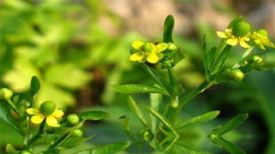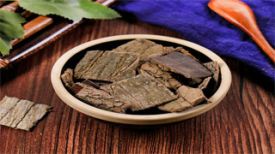
1. Aliases
Xinjiang Xuelian.2. Plant morphology
Perennial herbaceous plant, 15-35 centimeters tall. The rhizome is robust and has brown persistent petioles. The stem is hairless, with a diameter of 2-3 centimeters. Leaves dense, basal and stem leaves sessile, leaves elliptical or oval shaped, base extending downwards, apex acute, edge with sharp teeth, both sides hairless, the topmost leaves are bract like, wide oval, 5.5-7 cm long, edge with sharp teeth, membranous, light yellow, enveloping the inflorescence. The head shaped inflorescence is sessile, with 10-20 densely integrated spherical inflorescences on the stem. The bracts are hemispherical in shape, with a diameter of 1 cm. The bracts have 3-4 layers, with edges or all purple brown. The outer layer is elongated, 1.1 cm long, sparsely covered with long pubescence. The middle and inner layers are lanceolate, 1.5-1.8 cm long. The small flower is purple. Achenes are elongated in shape, with a dirty white crown and two layers. The flowering and fruiting period is from July to September.
3. Origin distribution
Born in valleys, crevices, water edges, and grasslands at an altitude of 2400-4100 meters. Distributed in Xinjiang.
4. Harvesting and processing
Harvest when the flowers bloom in summer and autumn, pull out the entire plant, remove sediment, and dry in the shade.
5. Characteristics of medicinal herbs
The stem is cylindrical, 20-48 centimeters long, with a diameter of 0.5-3 centimeters; The surface is yellow green or yellow brown, some are slightly purple, with longitudinal edges and a hollow cross-section. The stem leaves are densely arranged, sessile, or shed with residual bases. The intact leaves are oval shaped or broadly lanceolate, with pubescence on both sides and serrated and ciliated edges. The main veins are obvious. The head shaped inflorescence is terminal, with 10-42 densely packed spherical shapes and no stalks. The bracts are ovate or ovate, sessile, with a central depression resembling a boat, membranous, and semi transparent. The total bracts are 3-4 layers, lanceolate and of equal length. The outer layer is mostly purple brown, while the inner layer is brownish yellow or yellow white. Flower tubular, purple red, stigma 2-lobed. Achenes cylindrical, longitudinally ribbed, with two layers of feather like crown hairs. Lightweight and brittle in texture. The air is slightly fragrant and the taste is slightly bitter.
6. Nature, taste, and meridian tropism
Warm in nature and slightly bitter in taste. There is no meridian.
7. Effect and function
Warm the kidney and assist yang, dispel wind and overcome dampness, promote meridians and blood circulation. A Yang tonifying medicine belonging to the subcategory of tonifying deficiency medicine.
8. Clinical applications
Dosage 3-6 grams, boiled in water or soaked in wine. Apply in moderation for external use. Used for wind cold dampness pain, rheumatoid arthritis, lower abdominal cold pain, menstrual disorders.
9. Pharmacological research
1. It has anti-cancer effects. 2. Effects on the cardiovascular system: Both total alkaloids and ethanol extracts of snow lotus can reduce the permeability of skin blood vessels in rabbits, with strong effects. 3. Effect on smooth muscle: Total alkaloids of snow lotus have a significant antispasmodic effect on isolated rabbit smooth muscle spasms caused by histamine, pilocarpine, and acetylcholine. 4. Anti inflammatory effect: 5% total alkaloids of Xuelian (2ml/kg) and 10g ethanol extract of Xuelian (raw medicine)/kg intraperitoneal injection have significant antagonistic effects on acute inflammation of the hind ankle joint in rats caused by egg white solution, but the total alkaloids have the strongest effect. 5. Anti free radical and anti fatigue effects: Polysaccharides extracted from the Tian Shan snow lotus flower were measured to have a semi clearance concentration of 22.0 µ g/ml for superoxide anion free radicals using the nitrogen blue tetrazole colorimetric method. Polysaccharides can significantly inhibit the production of thiobarbituric acid reactants in mouse liver homogenate.
10. Chemical composition
The whole plant contains pharmacologically active polysaccharides with an average molecular weight of 16000, as well as sesquiterpenoid lactone and flavonoid components. Also containing volatile oil
11. Taboos for use
Pregnant women should avoid using it.
12. Compatibility prescription
Treatment of rheumatoid arthritis: 15 grams of snow lotus, 100 milliliters of alcohol added, soaked for 7 days. Take 10 milliliters each time, twice a day. Alternatively, it can be prepared as a 10% injection for intramuscular or acupoint injection. (Chinese Herbal Medicine in Xinjiang)
The content of the article is for clinical reference only. Non professionals in traditional Chinese medicine are not allowed to try medication.


